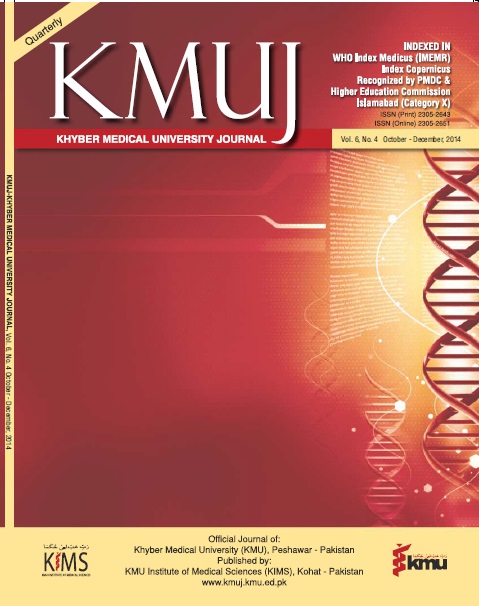PERIPARTUM HYSTERECTOMY; FREQUENCY, RISK FACTORS AND MATERNAL OUTCOME
Main Article Content
Abstract
OBJECTIVE: To observe the frequency, indications and maternal
outcome associated with peripartum obstetrical hysterectomy and
to explore the preventable factors contributing towards the adverse
outcome.
METHODOLOGY: This cross-sectional descriptive observational study
was conducted at Women and Children Teaching Hospital, Bannu and
included all the patients who underwent peripartum hysterectomy due
to obstetrical complication from 1st Jan 2009 to 30th June 2010. Clinical
and socio-demographic data was collected for analysis.
RESULTS: During the study period, 4583 deliveries were conducted
and peripartum hysterectomies were performed in 34 (0.74%) patients.
Uterine rupture was the commonest indication (62%) and there was
no specific preference found for any type of hysterectomy. Most of
the subjects were transfused more than three units of blood and 40%
developed either acute potentially fatal or long term debilitating complications while the case fatality rate (CFR) was 2.9%. Grandmultiparity (n=24, 70.59%), previous or current cesarean section (n=22, 64.71%) and injudicious use of uterotonics during labour (n=21, 61.76%) were the common risk factors associated with peripartum hysterectomies and their morbidities. Shock (n=20, 58.82%), disseminated intravascular coagulation (n=5, 14.70%) and urinary tract injury (n=5, 14.70%) were the commonest complications.
CONCLUSION: Peripartum hysterectomies, performed in <1% deliveries
in our set up, are commonly performed for uterine rupture, with
CFR of 2.9%. Grandmultiparity and previous or current cesarean section
are common risk factors and shock is the commonest complication of
peripartum hysterectomy. Regular training and clinical audit of birth
attendants to prevent prolonged obstructed labor or hyperstimulation
of uterus may reduce this complication.
KEY WORDS: Peripartum hysterectomy, Uterine rupture, Postpartum
haemorrhage, maternal morbidity, maternal mortality.
Article Details
Work published in KMUJ is licensed under a
Creative Commons Attribution 4.0 License
Authors are permitted and encouraged to post their work online (e.g., in institutional repositories or on their website) prior to and during the submission process, as it can lead to productive exchanges, as well as earlier and greater citation of published work.
(e.g., in institutional repositories or on their website) prior to and during the submission process, as it can lead to productive exchanges, as well as earlier and greater citation of published work.
References
Sparić R, Kadija S, Hudelist G, Glisić A,
Buzadzić S. History of caesarean hysterectomy.
Acta Chir Iugosl. 2012; 59(1): 9-12.
Tunçalp O, Hindin MJ, Souza JP, Chou D,
Say L. The prevalence of maternal near
miss: A systematic review. BJOG 2012;
(6): 653-61.
Lone F, Sultan AH, Thakar R, Beggs A.
Risk factors and management patterns for
emergency obstetric hysterectomy over
decades. Int J Gynaecol Obstet 2010;
(1): 12-5.
Awan N, Bennett MJ, Walters WA. Emergency
peripartum hysterectomy: a 10-year
review at the Royal Hospital for Women,
Sydney. Aust N Z J Obstet Gynaecol 2011
Jun; 51(3): 210-5.
Okeke TC, Ezenyeaku CC, Ikeako LC.
Caesarean hysterectomy. Niger J Med.
Apr-Jun; 22 (2): 83-8.
Güngördük K, Yildirim G, Dugan N, Polat
I, Sudolmus S, Ark C. Peripartum hysterectomy
in Turkey: A case-control study.J
Obstet Gynaecol 2009; 29(8): 722-8.
Kayabasoglu F, Guzin K, Aydogdu S,
Sezginsoy S, Turkgeldi L, Gunduz G.
Emergency peripartum hysterectomy in
a tertiary Istanbul hospital. Arch Gynecol
Obstet 2008; 278(3): 251-6.
Demirci O, Tuğrul AS, Yilmaz E, Tosun Ö,
Demirci E, Eren YS. Emergency peripartum
hysterectomy in a tertiary obstetric
center: nine years evaluation. J Obstet
Gynaecol Res 2011; 37(8): 1054-60.
Mlyncek M, Kellner M, Uharcek P, Matejka
M, Lajtman E, Boledovicová M. [Peripartum
hysterectomy--an audit in Slovakia in
. Ceska Gynekol. 2010; 75(2): 88-92.
Wong TY. Emergency peripartum hysterectomy:
a 10-year review in a tertiary
obstetric hospital. N Z Med J 2011;
(1345): 34-9.
Chibber R, Al-Hijji J, Fouda M, Al-Saleh E,
Al-Adwani AR, Mohammed AT. A 26-year
review of emergency peripartum hysterectomy
in a tertiary teaching hospital in
Kuwait - years 1983-2011. Med Princ Pract
; 21(3): 217-22.
Rabiu KA, Akinlusi FM, Adewunmi AA,
Akinola OI. Emergency peripartum hysterectomy
in a tertiary hospital in Lagos,
Nigeria: a five-year review. Trop Doct
Nwobodo E, Nnadi D. Emergency obstetric
hysterectomy in a tertiary hospital in
sokoto, Nigeria. Ann Med Health Sci Res
; 2(1): 37-40.
Khan B, Khan B, Sultana R, Bashir R,
Deeba F. A ten year review of emergency
peripartum hysterectomy in a tertiary care
hospital. J Ayub Med Coll Abbottabad.
; 24(1): 14-7.
Saeed F, Khalid R, Khan A, Masheer S, Rizvi
JH. Peripartum hysterectomy: a ten-year
experience at a tertiary care hospital in
a developing country. Trop Doct 2010;
(1): 18-21.
Christopoulos P, Hassiakos D, Tsitoura
A, Panoulis K, Papadias K, Vitoratos N.
Obstetric hysterectomy: a review of cases
over 16 years. J Obstet Gynaecol. 2011;
(2): 139-41.
Ossola MW, Somigliana E, Mauro M, Acaia
B, Benaglia L, Fedele L. Risk factors for
emergency postpartum hysterectomy:
the neglected role of previous surgically
induced abortions. Acta Obstet Gynecol
Scand 2011; 90(12): 1450-3.
Daskalakis G, Anastasakis E, Papantoniou
N, Mesogitis S, Theodora M, Antasaklis A.
Emergency Obstetric Hysterectomy. Acta
Obstetricia et Gynecologica Scandinavica.
; 86: 223-227.
Luo da S, Chen LL, Wei P, Jiang Z, Guo Y.
Applicability of lives saved tool in projecting
effects of scaling up interventions on
reducing maternal mortality rates in the
rural area of Guangxi province in China.
Beijing Da Xue Xue Bao. 2013 Jun 18;
(3): 427-31.
De-bernis.L, Dumont. A, Bouillin. D,
Gueye. A, Dompnier J.P, Bouvier-Colle
M.H. Maternal morbidity and mortality
in two different populations of Senegal: a
prospective study (MOMA Survey). BJOG.
Jan; 07(1): 68-74.
Pakistan. Demographic and Health Survey
-13. National Institute of Population
Studies, Islamabad, Pakistan. MEASURE
DHS, ICF, International. Calverton, Maryland
USA, June 2013.
Fofie C, Baffoe P. A two-year review of
uterine rupture in a regional hospital.
Ghana Med J 2010; 44(3): 98-102.
